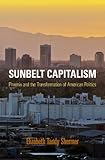Sunbelt Capitalism : Phoenix and the Transformation of American Politics / Elizabeth Tandy Shermer.
Material type: TextSeries: Politics and Culture in Modern AmericaPublisher: Philadelphia : University of Pennsylvania Press, [2013]Copyright date: ©2013Description: 1 online resource (432 p.) : 18 illusContent type:
TextSeries: Politics and Culture in Modern AmericaPublisher: Philadelphia : University of Pennsylvania Press, [2013]Copyright date: ©2013Description: 1 online resource (432 p.) : 18 illusContent type: - 9780812244700
- 9780812207606
- 307.7609791/73
- HT384.U62 ǂb A68 2013eb
- online - DeGruyter
- Issued also in print.
| Item type | Current library | Call number | URL | Status | Notes | Barcode | |
|---|---|---|---|---|---|---|---|
 eBook
eBook
|
Biblioteca "Angelicum" Pont. Univ. S.Tommaso d'Aquino Nuvola online | online - DeGruyter (Browse shelf(Opens below)) | Online access | Not for loan (Accesso limitato) | Accesso per gli utenti autorizzati / Access for authorized users | (dgr)9780812207606 |
Browsing Biblioteca "Angelicum" Pont. Univ. S.Tommaso d'Aquino shelves, Shelving location: Nuvola online Close shelf browser (Hides shelf browser)

|

|

|

|

|

|

|
||
| online - DeGruyter Frontier Cities : Encounters at the Crossroads of Empire / | online - DeGruyter Clan Cleansing in Somalia : The Ruinous Legacy of 1991 / | online - DeGruyter Race, Riots, and Roller Coasters : The Struggle over Segregated Recreation in America / | online - DeGruyter Sunbelt Capitalism : Phoenix and the Transformation of American Politics / | online - DeGruyter Conversion and Narrative : Reading and Religious Authority in Medieval Polemic / | online - DeGruyter The Pennsylvania Railroad, Volume 1 : Building an Empire, 1846-1917 / | online - DeGruyter Miami Transformed : Rebuilding America One Neighborhood, One City at a Time / |
Frontmatter -- Contents -- Introduction -- Part I. Desert -- Chapter 1. Colonial Prologue -- Chapter 2. Contested Recovery -- Chapter 3. The Business of War -- Part II. Reclamation -- Chapter 4. The Right to Rule -- Chapter 5. Grasstops Democracy -- Chapter 6. Forecasting the Business Climate -- Chapter 7. "Second War Between the States" -- Part III. Sprawl -- Chapter 8. Industrial Phoenix -- Chapter 9. The Conspicuous Grasstops -- Chapter 10. "A Frankenstein's Monster" -- Epilogue Whither Phoenix? -- Abbreviations -- Notes -- Index -- Acknowledgments
restricted access online access with authorization star
http://purl.org/coar/access_right/c_16ec
Few Sunbelt cities burned brighter or contributed more to the conservative movement than Phoenix. In 1910, eleven thousand people called Phoenix home; now, over four million reside in this metropolitan region. In Sunbelt Capitalism, Elizabeth Tandy Shermer tells the story of the city's expansion and its impact on the nation. The dramatic growth of Phoenix speaks not only to the character and history of the Sunbelt but also to the evolution in American capitalism that sustained it.In the 1930s, Barry Goldwater and other members of the Phoenix Chamber of Commerce feared the influence of New Deal planners, small businessmen, and Arizona trade unionists. While Phoenix's business elite detested liberal policies, they were not hostile to government action per se. Goldwater and his contemporaries instead experimented with statecraft now deemed neoliberal. They embraced politics, policy, and federal funding to fashion a favorable "business climate," which relied on disenfranchising voters, weakening unions, repealing regulations, and shifting the tax burden onto homeowners and consumers. These efforts allied them with executives at the helm of the modern conservative movement, whose success partially hinged on relocating factories from the Steelbelt to the kind of free-enterprise oasis that Phoenix represented. But the city did not sprawl in a vacuum. All Sunbelt boosters used the same incentives to compete at a fever pitch for investment, and the resulting drain of jobs and capital from the industrial core forced Midwesterners and Northeasterners into the brawl. Eventually this "Second War Between the States" reoriented American politics toward the principle that the government and the citizenry should be working in the interest of business.
Issued also in print.
Mode of access: Internet via World Wide Web.
In English.
Description based on online resource; title from PDF title page (publisher's Web site, viewed 24. Apr 2022)


